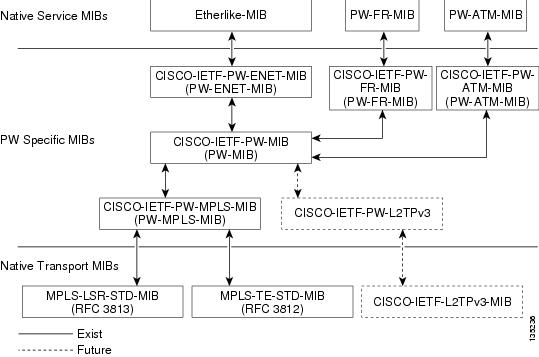AAL
—ATM adaptation layer. AAL defines the conversion of user information into cells. AAL1 and AAL2 handle isochronous traffic,
such as voice and video; AAL3/4 and AAL5 pertain to data communications through the segmentation and reassembly of packets.
ATM
—asynchronous transfer mode. A cell-based data transfer technique in which channel demand determines packet allocation. This
is an international standard for cell relay in which multiple service types (such as voice, video, or data) are conveyed in
fixed-length (53-byte) cells. Fixed-length cells allow cell processing to occur in hardware, thereby reducing transit delays.
ATM is designed to take advantage of high-speed transmission media such as E3, SONET, and T3.
CE router —customer edge router. A router that is part of a customer network and that interfaces to a provider edge (PE) router.
DLCI
—data-link connection identifier. A unique number assigned to a PVC endpoint in a Frame Relay network. Identifies a particular
PVC endpoint within an access channel in a Frame Relay network and has local significance only to that channel.
encapsulation
—Wrapping of data in a particular protocol header. For example, Ethernet data is wrapped in a specific Ethernet header before
network transit. Also, when bridging occurs in dissimilar networks, the entire frame from one network is simply placed in
the header used by the data link layer protocol of the other network.
EoMPLS
—Ethernet over multiprotocol label switching (MPLS). A tunneling mechanism that allows a service provider to tunnel customer
Layer 2 traffic through a Layer 3 MPLS network. EoMPLS is a point-to-point solution only. EoMPLS is also known as Layer 2
tunneling.
Frame Relay —The industry standard, switched data link layer protocol that handles multiple virtual circuits using High-Level Data Link
Control (HDLC) encapsulation between connected devices. Frame Relay is more efficient than X.25, the protocol for which it
is generally considered a replacement.
IETF
—internet engineering task force. A task force (consisting of more than 80 working groups) that is developing standards for
the Internet and the IP suite of protocols.
LDP
—label distribution protocol. The protocol that supports MPLS hop-by-hop forwarding and the distribution of bindings between
labels and network prefixes. The Cisco proprietary version of this protocol is the Tag Distribution Protocol (TDP).
LSP
—label switched path. A configured connection between two label switch routers (LSRs) in which label-switching techniques
are used for packet forwarding; also a specific path through an MPLS network.
LSR
—label switch router. A Multiprotocol Label Switching (MPLS) node that can forward native Layer 3 packets. The LSR forwards
a packet based on the value of a label attached to the packet.
MIB —management information base. A database of network management information that is used and maintained by a network management
protocol such as simple network management protocol (SNMP). The value of a MIB object can be changed or retrieved by using
SNMP commands, usually through a network management system. MIB objects are organized in a tree structure that includes public
(standard) and private (proprietary) branches.
MPLS —multiprotocol label switching. A switching method for the forwarding of IP traffic through the use of a label. This label
instructs the routers and the switches in the network where to forward the packets based on preestablished IP routing information.
MTU
—maximum transmission unit. Maximum packet size, in bytes, that a particular interface can handle.
NMS —network management system. System responsible for managing at least part of a network. An NMS is generally a reasonably powerful
and well-equipped computer, such as an engineering workstation. An NMS communicates with agents to help keep track of network
statistics and resources.
notification
—A message sent by a Simple Network Management Protocol (SNMP) agent to a network management station, console, or terminal
to indicate that a significant network event has occurred. See also trap.
OSPF
—Open Shortest Path First. A link-state hierarchical Interior Gateway Protocol routing algorithm, derived from the IS-IS protocol.
OSPF features include least-cost routing, multipath routing, and load balancing.
PE router —provider edge router. A router that is part of a service provider’s network and is connected to a customer edge (CE) router.
primary tunnel —A tunnel whose label-switched path (LSP) may be fast rerouted if there is a failure. Backup tunnels cannot be primary tunnels.
pseudowire
—PW. A mechanism that carries the elements of an emulated service from one provider edge (PE) to one or more PEs over a packet
switched network (PSN).
SNMP —simple network management protocol. A management protocol used almost exclusively in TCP/IP networks. SNMP provides a means
for monitoring and controlling network devices, and for managing configurations, statistics collection, performance, and security.
trap —A message sent by an SNMP agent to a network management station, console, or terminal, indicating that a significant event
occurred. Traps are less reliable than notification requests because the receiver does not send an acknowledgment when it
receives a trap. The sender cannot determine if the trap was received.
tunnel
—A secure communication path between two peers, such as routers.
VC
—virtual circuit. A logical circuit created to ensure reliable communication between two network devices. A virtual circuit
can be either permanent (PVC) or switched (SVC).



 Feedback
Feedback